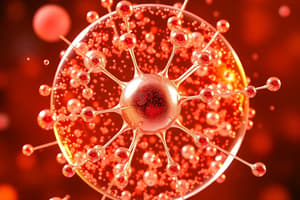Podcast
Questions and Answers
Which state of matter is characterized by particles tightly packed together and having low kinetic energy?
Which state of matter is characterized by particles tightly packed together and having low kinetic energy?
- Liquid
- Plasma
- Gas
- Solid (correct)
Which state of matter is difficult to compress and has a lower density than solids?
Which state of matter is difficult to compress and has a lower density than solids?
- Liquid (correct)
- Solid
- Plasma
- Gas
What is the primary characteristic of gases in terms of particle behavior?
What is the primary characteristic of gases in terms of particle behavior?
- Particles widely spaced apart and high kinetic energy (correct)
- Low kinetic energy and tightly packed particles
- Particles have low density
- Particles fixed in both shape and volume
Which state of matter is a highly energized form consisting of ions and electrons moving freely?
Which state of matter is a highly energized form consisting of ions and electrons moving freely?
In which state of matter do particles take the shape of their container?
In which state of matter do particles take the shape of their container?
Which state of matter has particles that can be easily compressed?
Which state of matter has particles that can be easily compressed?
What is the state of matter where particles are closely packed together and the electrons are constantly moving but cannot escape the nucleus of the atom?
What is the state of matter where particles are closely packed together and the electrons are constantly moving but cannot escape the nucleus of the atom?
Which state of matter has particles that are not tightly bound to each other and carry an electrical charge, allowing them to conduct electricity?
Which state of matter has particles that are not tightly bound to each other and carry an electrical charge, allowing them to conduct electricity?
According to the particle theory of matter, what are the tiny, indivisible units that all matter is made up of?
According to the particle theory of matter, what are the tiny, indivisible units that all matter is made up of?
Which state of matter has particles that have some space between them, allowing them to move around and slide past each other?
Which state of matter has particles that have some space between them, allowing them to move around and slide past each other?
In which state of matter are the particles widely spaced apart and free to move around randomly in any direction?
In which state of matter are the particles widely spaced apart and free to move around randomly in any direction?
What is Bose-Einstein condensate (BEC)?
What is Bose-Einstein condensate (BEC)?
Flashcards are hidden until you start studying
Study Notes
Matter in Our Surroundings: Understanding States of Matter and Particle Theory
Matter is a fundamental concept in the natural sciences, and it is the basic substance that makes up everything around us. This article will delve into the understanding of matter in our surroundings, focusing on its states and the particle theory of matter.
States of Matter
Matter exists in various states, including solid, liquid, gas, plasma, Bose-Einstein condensate (BEC), and other exotic forms. These states are characterized by the way the particles of matter interact with each other and their environment.
-
Solid: In solids, particles are tightly packed together and have low kinetic energy. Solids maintain a fixed shape and volume and do not conform to the shape of their container.
-
Liquid: In liquids, particles are more loosely packed and can flow around each other, taking on the shape of their container. Liquids are difficult to compress and have a lower density than solids.
-
Gas: In gases, particles have high kinetic energy and are widely spaced apart, filling any container they are placed in. Gases can be easily compressed and have a lower density than liquids.
-
Plasma: Plasma is a highly energized state of matter, consisting of ions and electrons moving freely. It is found in various natural phenomena, such as lightning and plasma TVs.
-
Bose-Einstein Condensate (BEC): BEC is a state of matter achieved at extremely low temperatures, where the particles start to behave as a single, coherent entity. This state is used for research on quantum mechanics and other advanced phenomena.
Particle Theory of Matter
The particle theory of matter states that all matter is made up of tiny, indivisible units called atoms and molecules. These particles are held together by various forces, such as cohesive and adhesive forces. The properties of a substance, such as its state, are determined by the characteristics of its constituent particles.
-
Solid: In solids, the particles are closely packed together, and the electrons are constantly moving but cannot escape the nucleus of the atom.
-
Liquid: In liquids, the particles have some space between them, allowing them to move around and slide past each other.
-
Gas: In gases, the particles are widely spaced apart, and they are free to move around randomly in any direction.
-
Plasma: In plasmas, the particles are not tightly bound to each other, and they carry an electrical charge, allowing them to conduct electricity.
Understanding the states of matter and the particle theory of matter is crucial for understanding the properties and behavior of the materials in our surroundings. By exploring these concepts, we can gain a deeper appreciation of the world around us.
Studying That Suits You
Use AI to generate personalized quizzes and flashcards to suit your learning preferences.




